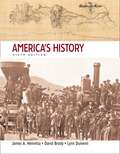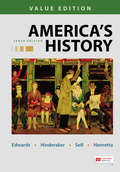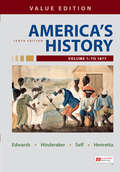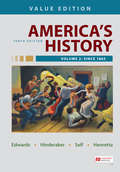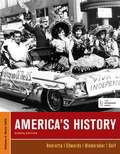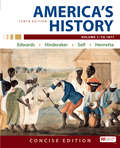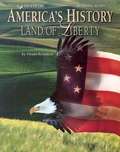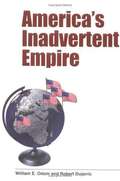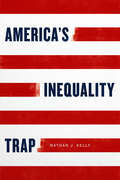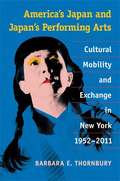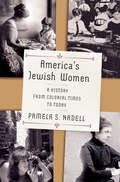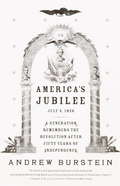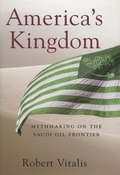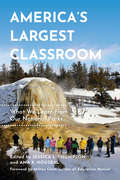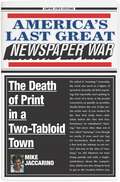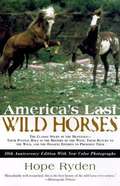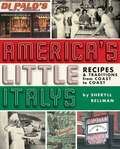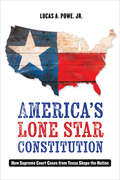- Table View
- List View
America's History, Sixth Edition
by James A. Henretta Lynn Dumenil David BrodyHigh School AP U.S. history textbook
America's History, Value Edition, Combined Volume: 2 Books Set
by James A. Henretta Rebecca Edwards Robert O. Self Eric HinderakerAmerica’s History explains WHY events occurred, not just when. Students are provided an analytical and big-picture approach to American history in an affordable format.
America's History, Value Edition, Volume 1: 2 Books Set
by James A. Henretta Rebecca Edwards Robert O. Self Eric HinderakerAmerica’s History explains WHY events occurred, not just when. Students are provided an analytical and big-picture approach to American history in an affordable format.
America's History, Value Edition, Volume 2: 2 Books Set
by James A. Henretta Rebecca Edwards Robert O. Self Eric HinderakerAmerica’s History explains WHY events occurred, not just when. Students are provided an analytical and big-picture approach to American history in an affordable format.
America's History, Vol II (Eighth Edition)
by James A. Henretta Rebecca Edwards Robert O. SelfHelp your students think historically Known for its interpretive voice and thoughtful analysis, America's History models exactly the kind of thinking and writing students need to be successful. An accessible and balanced narrative with built-in primary sources and skills-based pedagogy gives students practice in thinking historically, and features new ways of mastering the content so that students come to class prepared.
America's History, Volume 1: Concise Edition
by James A. Henretta Rebecca Edwards Robert O. Self Eric HinderakerAmerica�s History explains WHY events occurred, not just when. Students are provided an analytical and big-picture approach to American history with a plethora of support tools.
America's History, Volume 2: Concise Edition
by James A. Henretta Rebecca Edwards Robert O. Self Eric HinderakerAmerica�s History explains WHY events occurred, not just when. Students are provided an analytical and big-picture approach to American history with a plethora of support tools.
America's History: Land of Liberty
by John L. Esposito Vivian Bernstein Steck-Vaughn Staff Mel MillerAs you go through this book, you will discover how people created a new nation in North America that was different from any other country. Every chapter starts with statements made to encourage readers in the units and chapters. There are questions presented at the beginning of every chapter that help students to focus on the main ideas throughout the book.
America's History: Land of Liberty
by Vivian BernsteinAmerica's early Years, From Colonies to a Nation, The Nation grows and Changes, The Civil War and Reconstruction, The United States becomes an Industrial Nation, The United States as a World Power, The Great Depression and World War II, The Years after World War II, The United States Today and Tomorrow.
America's History: Land of Liberty, Beginning to 1877
by Vivian BernsteinAs you read America's History: Land of Liberty, you will discover how people created a new nation in North America that was different from any other country. That nation, the United States of America, was the only nation at the end of the 1700s where people made their own laws and ruled themselves without a king or queen. It was a great experiment because no one knew if a nation with such a government could survive. You will learn how the new nation not only survived, but grew larger and stronger.
America's Imagined Revolution: The Historical Novel of Reconstruction (Southern Literary Studies)
by Tomos Wallbank-HughesAmerica’s Imagined Revolution explores the Reconstruction period after the Civil War to ask narratological, historiographical, and theoretical questions about how slave emancipation has (and has not) been theorized as revolution. Reading historical fiction by authors such as George Washington Cable, Albion Tourgée, Charles Chesnutt, Frances Harper, and W. E. B. Du Bois in dialogue with nineteenth-century historical writing—and the era’s legal, political, and print culture—Tomos Wallbank-Hughes excavates an evanescent form of historicist writing sensitive to the revolutionary changes that shaped life in the emancipation-era South.As an aesthetic form, the historical novel of Reconstruction poses questions about revolutionary experience in plantation societies, and in the process challenges critical assumptions about historical time in the nineteenth century: How do authors narrate epochal change that also feels like retrenchment? In what direction does history travel if it does not progress? What narratives of race, class, and region encompass both continued domination and ruptured power? By plumbing the situations that give it form, the historical novel of Reconstruction provides a window into the literary culture of the South’s long nineteenth century in which, rather than a storehouse of tradition, the region became a terrain for interpreting social revolution and uncovering slavery’s revolutionary afterlives.America’s Imagined Revolution offers a new interpretation of the literary and historiographical significance of the Reconstruction period and its relationship to American literary history.
America's Inadvertent Empire
by William E. Odom Robert DujarricThe United States finds itself at the center of an empire of a new type, wealth-generating and voluntary, not a traditional imperial system, say the authors of this compelling book. William E. Odom and Robert Dujarric examine America's unprecedented power within the international arenas of politics, economics, demographics, education, science, and culture. They argue persuasively that the major threat to this unique empire is ineffective U. S. leadership, not a rising rival power center. America cannot simply behave as an ordinary sovereign state, Odom and Dujarric contend. They describe the responsibilities that accompany staggering power advantages, and they explain that resorting to unilateralism makes sense only when it becomes necessary to overcome paralysis in multilateral organizations. The authors also offer insights into the importance of liberal international institutions as a source of power, why international cooperation pays, and why spreading democracy often inhibits the spread of constitutional order. If the United States uses its own power constructively, the authors conclude, the American empire will flourish for a long time. Book jacket.
America's Inequality Trap (Chicago Studies in American Politics)
by Nathan J. KellyThe gap between the rich and the poor has grown dramatically in the United States and is now at its widest since at least the early 1900s. While by most measures the economy has been improving, soaring cost of living and stagnant wages have done little to assuage economic anxieties. Conditions like these seem designed to produce a generation-defining intervention to balance the economic scales and enhance opportunities for those at the middle and bottom of the country’s economic ladder—but we have seen nothing of the sort. Nathan J. Kelly argues that a key reason for this is that rising concentrations of wealth create a politics that makes reducing economic inequality more difficult. Kelly convincingly shows that, when a small fraction of the people control most of the economic resources, they also hold a disproportionate amount of political power, hurtling us toward a self-perpetuating plutocracy, or an “inequality trap.” Among other things, the rich support a broad political campaign that convinces voters that policies to reduce inequality are unwise and not in the average voter’s interest, regardless of the real economic impact. They also take advantage of interest groups they generously support to influence Congress and the president, as well as state governments, in ways that stop or slow down reform. One of the key implications of this book is that social policies designed to combat inequality should work hand-in-hand with political reforms that enhance democratic governance and efforts to fight racism, and a coordinated effort on all of these fronts will be needed to reverse the decades-long trend.
America's Jails: The Search for Human Dignity in an Age of Mass Incarceration (Alternative Criminology #8)
by Derek JeffreysA look at the contemporary crisis in U.S. jails with recommendations for improving and protecting the dignity of inmates Twelve million Americans go through the U.S. jail system on an annual basis. Jails, which differ significantly from prisons, are designed to house inmates for short amounts of time, and are often occupied by large populations of legally innocent people waiting for a trial. Jails often have deplorable sanitary conditions, and there are countless records of inmates being brutalized by staff and other inmates while in custody. Local municipalities use jails to institutionalize those whom they perceive to be a threat, so hundreds of thousands of inmates suffer from mental illness. People abandoned by families or lacking health insurance, or those who cannot afford bail, often cycle in and out of jails. In America’s Jails, Derek Jeffreys draws on sociology, philosophy, history, and his personal experience volunteering in jails and prisons to provide an understanding of the jail experience from the inmates’ perspective, focusing on the stigma that surrounds incarceration. Using his research at Cook County Jail, the nation’s largest single-site jail, Jeffreys attests that jail inmates possess an inherent dignity that should govern how we treat them. Ultimately, fundamental changes in the U.S. jail system are necessary and America’s Jails provides specific policy recommendations for changing its poor conditions. Highlighting the experiences of inmates themselves, America’s Jails aims to shift public perception and understanding of jail inmates to center their inherent dignity and help eliminate the stigma attached to their incarceration.
America's Japan and Japan's Performing Arts: Cultural Mobility and Exchange in New York, 1952-2011
by Barbara E. ThornburyAmerica’s Japan and Japan’s Performing Arts studies the images and myths that have shaped the reception of Japan-related theater, music, and dance in the United States since the 1950s. Soon after World War II, visits by Japanese performing artists to the United States emerged as a significant category of American cultural-exchange initiatives aimed at helping establish and build friendly ties with Japan. Barbara E. Thornbury explores how “Japan” and “Japanese culture” have been constructed, reconstructed, and transformed in response to the hundreds of productions that have taken place over the past sixty years in New York, the main entry point and defining cultural nexus in the United States for the global touring market in the performing arts. Thornbury crosses disciplinary boundaries in her wide range of both primary sources and published scholarship, making the book of interest to students and scholars of performing arts studies, Japanese studies, and cultural studies.
America's Jewish Women: A History From Colonial Times To Today
by Pamela NadellA groundbreaking history of how Jewish women maintained their identity and influenced social activism as they wrote themselves into American history. What does it mean to be a Jewish woman in America? In a gripping historical narrative, Pamela S. Nadell weaves together the stories of a diverse group of extraordinary people—from the colonial-era matriarch Grace Nathan and her great-granddaughter, poet Emma Lazarus, to labor organizer Bessie Hillman and the great justice Ruth Bader Ginsburg, to scores of other activists, workers, wives, and mothers who helped carve out a Jewish American identity. The twin threads binding these women together, she argues, are a strong sense of self and a resolute commitment to making the world a better place. Nadell recounts how Jewish women have been at the forefront of causes for centuries, fighting for suffrage, trade unions, civil rights, and feminism, and hoisting banners for Jewish rights around the world. Informed by shared values of America’s founding and Jewish identity, these women’s lives have left deep footprints in the history of the nation they call home.
America's Journey: Continuity and Change in the Twentieth Century
by David Goldfield Carl Abbott Virginia Dejohn Anderson Jo Ann E. Argersinger Peter H. Argersinger William L. Barney Robert M. WeirA number of features in this book are designed to aid in the study of history. Each chapter begins with Questions, organized by the main subtopics of each chapter, that encourage careful consideration of important themes and developments.
America's Jubilee: A Generation Remembers the Revolution After 50 Years of Independence
by Andrew BursteinIn America's Jubilee distinguished historian Andrew Burstein presents an engrossing narrative that takes us back to a pivotal year in American history, 1826, when the reins of democracy were being passed from the last Revolutionary War heroes to a new generation of leaders. Through brilliant sketches of selected individuals and events, Burstein creates an evocative portrait of the hopes and fears of Americans fifty years after the Revolution. We follow an aged Marquis de Lafayette on his triumphant tour of the country; and learn of the nearly simultaneous deaths of John Adams and Thomas Jefferson on the 4th of July. We meet the ornery President John Quincy Adams, the controversial Secretary of State Henry Clay, and the notorious hot-tempered General Andrew Jackson. We also see the year through the eyes of a minister's wife, a romantic novelist, and even an intrepid wheel of cheese. Insightful and lively, America's Jubilee captures an unforgettable time in the republic's history, when a generation embraced the legacy of its predecessors and sought to enlarge its role in America's story.
America's Kingdom: Mythmaking on the Saudi Oil Frontier
by Robert VitalisIn telling the story of the Arabian American Oil Company (ARAMCO) in Saudi Arabia, Vitalis takes aim at a number of myths of exceptionalism he finds common to earlier narratives such as the PBS documentary "The Prize" and Thomas Lippman's "Inside the Mirage". These include the idea that ARAMCO was less exploitive than, say, mining companies in Africa and the idea that Saudi Arabia developed in relative international isolation and represents a relatively unique case in the history of extractive economies. His discussion looks at how ARAMCO officials set up a system of social hierarchy similar to Jim Crow or Apartheid in the oil town of Dhahran, explores the Saudi workers' challenges to this system of hierarchy and to their economic exploitation, and parallel challenges to the international oil hierarchy represented by ARAMCO from progressive state-building forces in the Saudi government.
America's Largest Classroom: What We Learn from Our National Parks
by Jessica L. ThompsonOver the past 100 years, visitor learning at America’s national parks has grown and evolved. Today, there are over 400 National Park Service (NPS) sites, representing over eighty million acres. Sites exist in every US state and territory and are located on land, at sea, in remote areas, and in major urban centers. Every year, more than 300 million people visit national parks, and several million of them are children engaged in one of many educational programs hosted by the NPS.America’s Largest Classrooms offers insight and practical advice for improving educational outreach at national parks as well as suggestions for classroom educators on how to meaningfully incorporate parks into their curricula. Via a wide collection of case studies—ranging from addressing inclusivity at parks and public lands to teaching about science and social issues—this book illustrates innovations and solutions that will be of interest to nature interpreters, outdoor educators, and policy makers, as well as professors in the sciences writ large.
America's Last Great Newspaper War: The Death of Print in a Two-Tabloid Town
by Mike JaccarinoNAMED A BEST BOOK OF THE WEEK BY THE NEW YORK POSTALSO AVAILABLE AS AN AUDIOBOOKA from-the-trenches view of New York Daily News and New York Post runners and photographers as they stop at nothing to break the story and squash their tabloid arch-rivals.When author Mike Jaccarino was offered a job at the Daily News in 2006, he was asked a single question: “Kid, what are you going to do to help us beat the Post?” That was the year things went sideways at the News, when the New York Post surpassed its nemesis in circulation for the first time in the history of both papers. Tasked with one job—crush the Post—Jaccarino here provides the behind-the-scenes story of how the runners and shooters on both sides would do anything and everything to get the scoop before their opponents.The New York Daily News and the New York Post have long been the Hatfields and McCoys of American media: two warring tabloids in a town big enough for only one of them. As digital news rendered print journalism obsolete, the fight to survive in NYC became an epic, Darwinian battle. In America’s Last Great Newspaper War, Jaccarino exposes the untold story of this tabloid death match of such ferocity and obsession its like has not occurred since Pulitzer– Hearst.Told through the eyes of hungry “runners” (field reporters) and “shooters” (photographers) who would employ phony police lights to overcome traffic, Mike Jaccarino’s memoir unmasks the do-whatever-it-takes era of reporting—where the ends justified the means and nothing was off-limits. His no-holds-barred account describes sneaking into hospitals, months-long stakeouts, infiltrating John Gotti’s crypt, bidding wars for scoops, high-speed car chases with Hillary Clinton, O.J. Simpson, and the baby mama of a philandering congressman—all to get that coveted front-page story.Today, few runners and shooters remain on the street. Their age and exploits are as bygone as the News–Post war and American newspapers, generally. Where armies once battled, often no one is covering the story at all.Funding for this book was provided by: Furthermore: a program of the J. M. Kaplan Fund
America's Last Wild Horses
by Hope RydenFrom the Book Jacket: "A richly researched and written book with an unusual appeal." -Publishers Weekly "This book is a treat for everyone who knows or cares about horses." -Cleveland Amory No wild animal captures the spirit of North America quite so powerfully as the wild horse-nor has any faced such diverse and potent enemies. In this provocative account, Hope Ryden-who helped to ensure the passage of the Wild and Free-Roaming Horse and Burro Act, which grants mustangs special protection-combs the history of these proud and noble horses; Descended from the Spanish horses ridden by the conquistadors, they evolved into the tough and intelligent ponies that Indians-and later, explorers and cowboys-learned to rely on. From the period when wholesale extermination of the buffalo was underway until recent times, commercial and political interests have sought to eliminate the wild horses as varmints. In the latest update to this classic story Ryden tells of the successes: and failures in the past ten years of regulation, and has added stunning new color photographs. The subject of a front-page article in The New York Times. when it was first published, america's last wild horses continues to be a compelling testament to the life of a uniquely American symbol of grace and wildness, and is a must read for horse lovers and Western history enthusiast everywhere.
America's Leaning Ivory Tower: The Measurement of and Response to Concentration of Federal Funding for Academic Research (SpringerBriefs in Political Science)
by Yonghong WuThis book will expand the body of literature on capacity-building in science and improve public understanding of the issues regarding geographical concentration of federal research funding. The federal government has been the primary sponsor of academic research in the U.S., and the peer-review system has been the primary mechanism for distributing federal government funding for research among universities. The peer-review system ensures the production of the best science by funding the most capable researchers in the country. As a result, federal research funding has been concentrated in high-capacity states where many of the most capable researchers reside. Despite official action - such as the implementation of the Experimental Program to Stimulate Competitive Research (EPSCoR), which targets low capacity jurisdictions for federal funding - the amount of resources going to each state for research is highly uneven. This book provides recommendations on how to improve policy design and program implementation for better research capacity-building outcomes. The book lends itself to a wide audience, as it does not focus entirely on high-level statistical analysis, but will have specific appeal to researchers in science policy, federal budgeting and higher education policy.
America's Little Italys: Recipes and Traditions from Coast to Coast
by Sheryll BellmanThe Italian Immigrant Experience Who could ever imagine a life without opera, pizza, or great art? These wonderful contributions of Italian culture have greatly influenced the American cultural landscape. During the nineteenth century, Italian immigrants came to the United States to forge a better, safer, and more prosperous life. They brought with them rich traditions that included love for romance, literature, science, commerce, style, and of course, most notably -- food.
America's Lone Star Constitution: How Supreme Court Cases From Texas Shape The Nation
by Lucas A. Powe Jr.Texas has created more constitutional law than any other state. In any classroom nationwide, any basic constitutional law course can be taught using nothing but Texas cases. That, however, understates the history and politics behind the cases. Beyond representing all doctrinal areas of constitutional law, Texas cases deal with the major issues of the nation. <p><p> Leading legal scholar and Supreme Court historian Lucas A. Powe, Jr., charts the rich and pervasive development of Texas-inspired constitutional law. From voting rights to railroad regulations, school finance to capital punishment, poverty to civil liberties, this wide-ranging and eminently readable book provides a window into the relationship between constitutional litigation and ordinary politics at the Supreme Court, illuminating how all of the fiercest national divides over what the Constitution means took shape in Texas.
